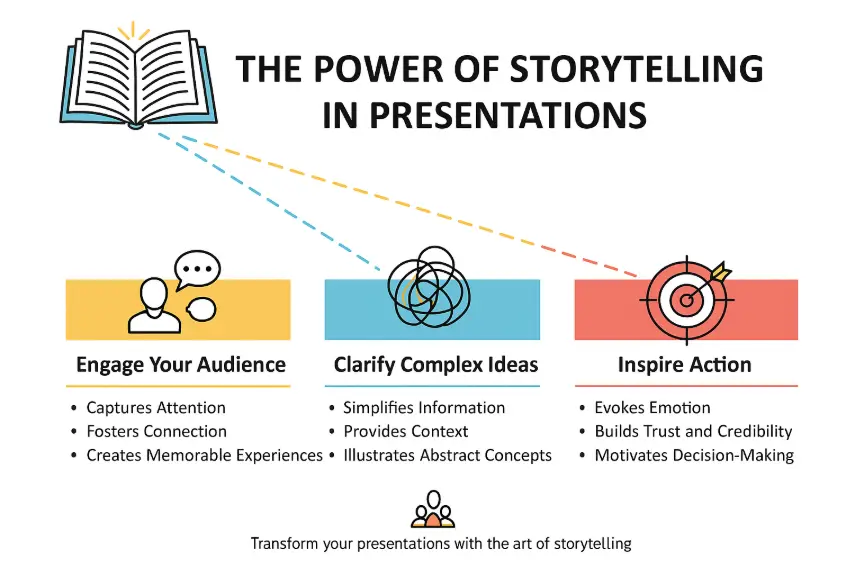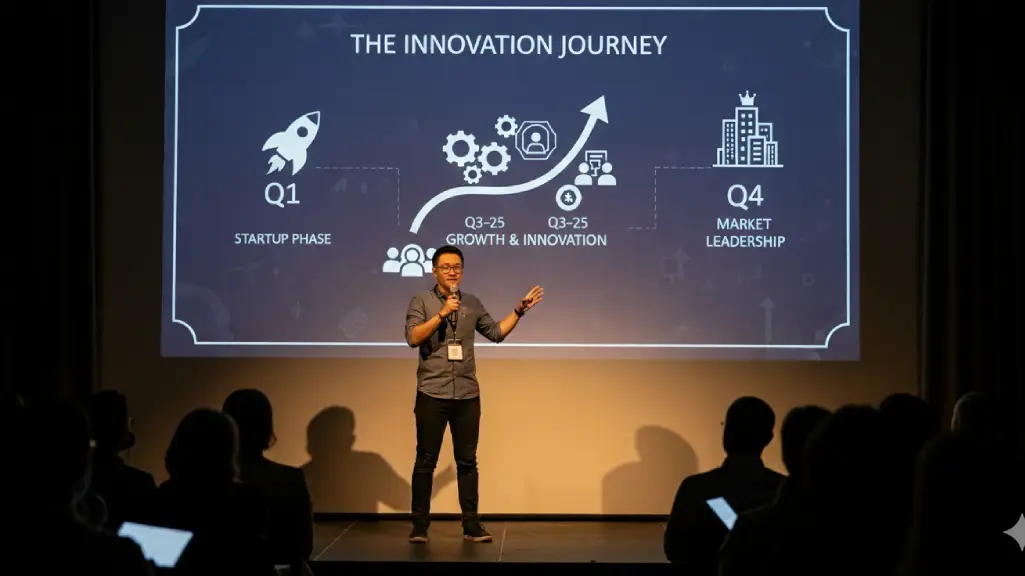We now live in a world where the attention span of humans is shorter than that of a goldfish – at less than 8 seconds – according to a Microsoft study. So, it is hardly surprising that even perfectly designed presentations fail to engage audiences.
However, there’s good news. There is a proven strategy that you can use to turn passive spectators into active listeners: tell a story!
5 Steps to Turn Your Presentations into a Story Everyone Remembers
Step 1: Understand What You’re Up Against, Besides a Shrinking Attention Span
- Information Overload – Most presentations contain generic point and charts and clip-style graphics
- Emotionless Delivery – Without a clear narrative, your data becomes unforgettable, even if it’s important.
- Use of Design Without Strategy – Visuals, no matter how stunning they are, do not keep audiences engaged.
Step 2: Wield the Magic of Storytelling
Stories are not just for children. Storytelling serves as an effective method that can generate powerful results.
There’s data to prove it…
- People remember stories 22 times better than plain data alone (Stanford)
- Emotional connections produce higher brand loyalty (Harvard Business Review)

Source: Inkorporated
Step 3: Explore Successful Case Studies
In the 1990s, it was common to use hand-sketched slides with projectors that needed Kodak devices to display printed slides which were mounted on them, all while hoping they would not get jammed.
Now, in 2025, right in the heart of the digital age, we have evolved to using real-time edits with AI tools that allow drag and drop design. You can also access PPT services and design platforms through a single click.
Yet, none of it is impactful without successful storytelling. Here are a few examples of successful story-driven presentations that kept their audiences hooked.
1. Dropbox (2007 Pitch Deck)
During its early days, Dropbox demonstrated a pitch deck that exemplified simplicity and clarity. The slides presented a clean minimalist format because each one contained vital visual elements that supported the message without unnecessary design elements or distractions.
The deck presented a relatable pain point followed by a direct and refined solution presentation. The presentation featured essential information through clear language which eliminated complex jargon and excessive details to create a simple understanding for investors who were non-technical.
The direct approach of this pitch created more than just communication — it generated confidence in the audience.
The investors could understand the concept together with its prospects right away. The result? Dropbox managed to obtain $1.2 million in funding through a remarkably efficient process.
Businesses can adopt this style to develop strategic story-based presentations which communicate value through the simplest and most compelling method.
2. Airbnb (2009 Pitch Deck)
The pitch deck of Airbnb exceeded the status of a typical business proposal because it transformed into a living story about the founders’ personal experiences.
The founder shared their personal journey through the presentation which created authentic connections with their audience members. The presentation displayed a transformative design structure which presented before-and-after scenarios to demonstrate how Airbnb would transform the world and travel industry.
The combination of emotional storytelling with concrete market data made the presentation effective for both emotional and intellectual engagement. The presentation employed a professional business template which served as its foundation while storytelling elements added warmth and relatability to the slides.
The fusion of story-based design with reliable data established instant trust which made investors trust the people along with the idea presented.
3. Charity Water
With real human stories at the center, Charity Water’s presentation combines attractive images with efficient data presentation methods.
The combination of high-quality visuals with organized infographics presented to the donors both the extent of the issue and the actual effects of donations. The design enhances donor results by providing both visual and emotional comprehension. The donors gained both intellectual comprehension and deep emotional connection to the mission.
This serves as textbook example of combining infographic design and emotional storytelling.
The result?
Infographic design perfectly merged with emotional storytelling to produce presentations which both inform and prompt immediate action.
Step 4: Understand What Sets Apart Award-winning Presentations
All successful presentations including investor pitches and internal sales decks must adhere to several fundamental principles.
Clarity Over Complexity
– One main message per slide. The design should use visuals that enhance the message instead of causing distractions while maintaining a brand-friendly aesthetic instead of overusing stock imagery.
Emotions First, Data Second
– Lead with the “why”, not the “what”. Every successful presentation must be driven by stating its purpose to ensure the audience remains connected.
Tailored to the Target Group or Audience
– Use language, tone, and visuals that resonate with them. The combination of stories with contrast and pattern helps improve audience memory retention.
Step 5: Consider Seeking Expert Advice
All successful presentations including investor pitches and internal sales decks must adhere to several fundamental principles.
When your upcoming presentation holds crucial importance, consider collaborating with brand storytelling experts. These professionals have the expertise and experience to transform your content from ordinary to exceptional with the latest graphic design trends and copy.
While rapid development of AI tools enables users to generate content within a short period of time, your messaging along with an effective strategy and human connection will always outperform AI tools in establishing your market position.
Choosing the Right Presentation Design Services for Your Needs
From pitch decks to infographics, every design service adds something different to your storytelling toolkit. Here’s how they can support your goals:
- Presentation Design Services: Clean, compelling slide visuals that support your message
- Pitch Deck Design Services: Investor-ready decks with strategic storytelling.
- Pitch Deck Agency: End-to-end content, design, and delivery support
- Financial Pitch Deck Presentation: Accurate, persuasive visuals that simplify complex data
- Infographic Design Services: Visual storytelling for stats, trends, or reports
- Custom PowerPoint Template Services: Branded, reusable templates tailored to your team
- Flyer Design Services: Elegant, on-brand company overviews for marketing or sales
- Corporate Brochure Design: Elegant, brand-related company overview for marketing or sales
Final Takeaways: Turning Presentations into Stories That Win Audiences
The bottom line is: You cannot change the data, but you can change the delivery.
Top businesses are understanding the power of storytelling to turn boring presentations to cut through the modern world’s slew of distractions and engage their audiences in the right way.
You don’t need to be a TED speaker.
Not having expensive animations or high-priced software is also not an issue.
You need a story.
Keep in mind that slides themselves do not drive sales, but compelling stories do.
So, before creating your next deck ask yourself this question:
“Am I telling a story they’ll remember—or just clicking through slides they’ll forget?”
At a time, when time is of the essence, start your presentation development by contacting a presentation design agency and selecting PPT services that create stories with visual effects.
Your presentation style holds equal importance to the content you present when the stakes are high.
Ready to transform your next presentation?
Great storytelling makes all the difference in pitch decks as well as sales proposals and corporate brochures and infographics.
Want a presentation that your audience will remember? We can assist you in creating a presentation that will be remembered rather than just viewed.

